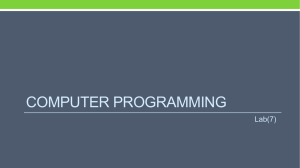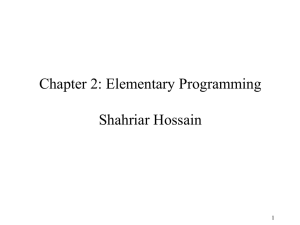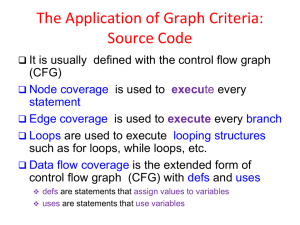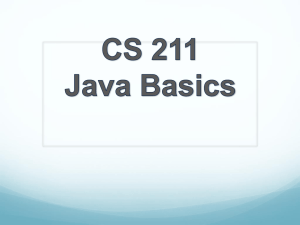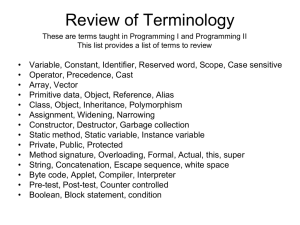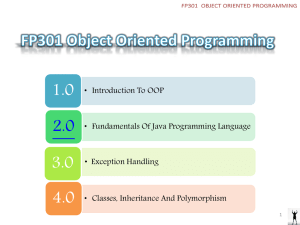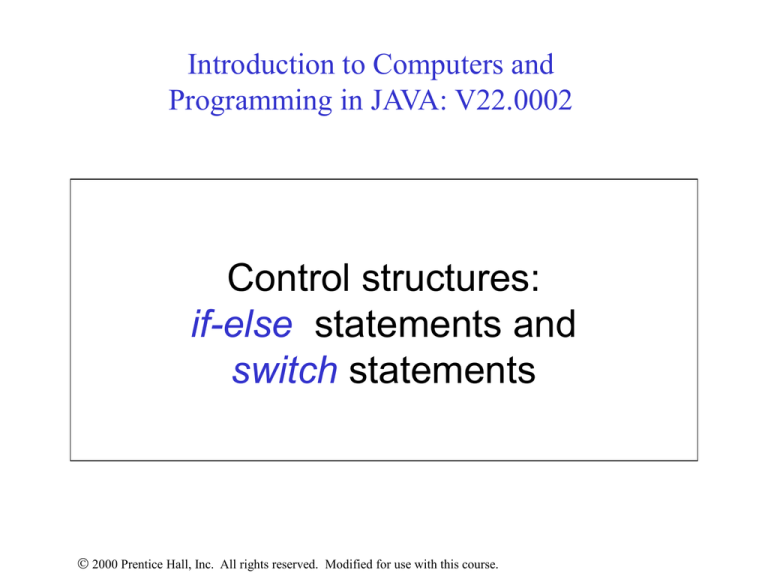
Introduction to Computers and
Programming in JAVA: V22.0002
Control structures:
if-else statements and
switch statements
2000 Prentice Hall, Inc. All rights reserved. Modified for use with this course.
2
Relational Operators (revisited)
Operator
Meaning
>
Greater than
<
Less than
>=
Greater than or equal to
<=
Less than or equal to
==
Equal to
!=
Not Equal to
2003 Prentice Hall, Inc. All rights reserved (Modified) .
3
Strings: example 1
public class string_example
//String concatenation
{
public static void main(String[] args)
{
//String is a class
String s1 = " The Cat ";
String s2 = " in the Hat";
String s3 = s1 + s2;//concatenation example
System.out.println(s3);
}
}
2003 Prentice Hall, Inc. All rights reserved (Modified) .
4
Strings -- example 2
import javax.swing.JOptionPane; //not in java.lang
public class string_example2
//concatenate two strings read from input
{
public static void main(String[] args)
{
String s1 = JOptionPane.showInputDialog("type 1st input");
String s2 = JOptionPane.showInputDialog("type 2nd input");
String s3 = s2 + s1;
System.out.println(s3);
System.exit(0); //required for JOptionPane
}
}
2003 Prentice Hall, Inc. All rights reserved (Modified) .
// less than five!!
import javax.swing.JOptionPane;
public class less_than_5{
public static void main(String args[]) {
// Prompt the user to enter a number:
String numString = JOptionPane.showInputDialog(null,
"Enter a number from 1 to 10:", "Input Window Demo",
JOptionPane.QUESTION_MESSAGE);
// Convert the string into an int value
int num = Integer.parseInt(numString);
// Display the result in a message dialog box
if ( num < 5 )
System.out.println(" The number " + num + " is less than five.");
else
if (num == 5)
System.out.println(" The number " + num + " is equal to five.");
else
System.out.println(" The number " + num + " is greater than five.");
System.exit(0);
}
2000 Prentice Hall, Inc. All rights reserved. (modified)
5
6
Another example: writing a program in class
about people’s ages:
• Program should ask user to input his or her
age
• Program should determine and print the
following based on the age:
– A person is a teenager if their age is 13 through
19
– You are too old to be a teenager
– You are too young to be a teenager
2000 Prentice Hall, Inc. All rights reserved. (modified)
// ages
import javax.swing.JOptionPane;
Nested if-else
public class age {
public static void main(String args[]) {
// Prompt the user to enter a number:
String numString = JOptionPane.showInputDialog(null,
"Enter your age:", "Input Window Demo",
JOptionPane.QUESTION_MESSAGE);
int age = Integer.parseInt(numString);
System.out.println(" Your age is " + age + ".");
// Convert the string into an int value
/* A person is a teenager if their age is 13 thu 19 */
if (age > 12)
if (age <20)
System.out.println("You are a teenager!\n");
else
System.out.println("You are too old to be a teenager!\n");
else
System.out.println("You are too young to be a teenager!\n");
System.exit(0);
}
}
2003 Prentice Hall, Inc. All rights reserved (Modified) .
7
// grades: example #2
import javax.swing.JOptionPane;
Nested if-else
public class grades_example2 {
public static void main(String args[]) {
// Prompt the user to enter a number:
String numString = JOptionPane.showInputDialog(null,
"Enter your grade (0-100):", "Input Window Demo",
JOptionPane.QUESTION_MESSAGE);
// Convert the string into an int value
int grade = Integer.parseInt(numString);
System.out.println("Your grade is " + grade + ".");
if (grade >= 90)
System.out.println("You got an \"A\".\n");
else if (grade >= 80)
System.out.println("You got a \"B\".\n");
else if (grade >= 70)
System.out.println("You got a \"C\".\n");
else if (grade >= 60)
System.out.println("You passed but you need a tutor.\n");
else
System.out.println("You failed.\n");
System.exit(0);
}
}
2003 Prentice Hall, Inc. All rights reserved (Modified) .
8
9
switch Multiple-Selection Structure
• Used when testing a variable or expression for
EQUALITY:
•
( >, <, >=, <=)
– tests separately for each of the constant integral values it
may assume.
• Preferred over if else in situations:
– where you are testing the same expressions for equality with
many different values.
• Allows you to perform different actions for each
test.
2003 Prentice Hall, Inc. All rights reserved (Modified) .
10
switch Multiple-Selection Structure
switch (expression) {
case value1:
action(s);
break;
keyword switch
expression can be a variable or
a more complicated expression
case value2:
action(s);
break;
…
default:
actions(s);
break;
could use more than one case;
if the same actions are required
actions within a single case do
not need brackets
the default case will be executed
in the event that no other case is
}
2003 Prentice Hall, Inc. All rights reserved (Modified) .
switch Multiple-Selection
FlowChart
True
Case a
action(s)
break
Case b
Case b
action(s)
break
Default
Default
action(s)
Case a
false
True
false
2003 Prentice Hall, Inc. All rights reserved (Modified) .
11
12
beware of “fall through”
• If you forget to use the break keyword
between cases, unexpected things may
happen.
• Once a case tests true, all the statements
following that case, will be executed until
the next break.
2003 Prentice Hall, Inc. All rights reserved (Modified) .
Nested if-else
//dice_using_if
import javax.swing.*;
public class dice_using_if {
public static void main( String args[] )
{
// Prompt the user to enter a number:
String numString = JOptionPane.showInputDialog(null,
"Roll the die!! (1-6):", "Input Window Demo",
JOptionPane.QUESTION_MESSAGE);
// Convert the string into an int value
int roll = Integer.parseInt(numString);
System.out.println(" You rolled a " + roll + ".");
if (roll == 1 )
System.out.println("You rolled a one! Try again! \n");
else if (roll == 2 )
System.out.println("You rolled a two! Too bad! \n");
else if (roll == 3 )
System.out.println("You rolled a three! Better luck next time! \n");
else if (roll == 4 )
System.out.println("You rolled a four! Sorry! \n");
else if (roll == 5 )
System.out.println("You rolled a five! Way to go!!\n");
else if (roll == 6 )
System.out.println("You rolled a six! I guess you win ...\n");
else
System.out.println("This is some wierd die! \n");
System.exit( 0 );
// terminate application
}}
2003 Prentice Hall, Inc. All rights reserved (Modified) .
13
Switch statements
// dice_using_switch
import javax.swing.*;
public class dice_using_switch {
public static void main( String args[] )
{
// Prompt the user to enter a number:
String numString = JOptionPane.showInputDialog(null,
"Roll the die!! (1-6):", "Input Window Demo",
JOptionPane.QUESTION_MESSAGE);
// Convert the string into an int value
int roll = Integer.parseInt(numString);
System.out.println(" You rolled a " + roll + ".");
switch ( roll ) {
case 1:
System.out.println("You rolled a one! Try again! \n");
break;
case 2:
System.out.println("You rolled a two! Too bad! \n");
break;
case 3:
System.out.println("You rolled a three! Better luck next time! \n");
break;
case 4:
System.out.println("You rolled a four! Sorry! \n");
break;
case 5:
System.out.println("You rolled a five! Way to go!!\n");
break;
case 6:
System.out.println("You rolled a six! I guess you win ...\n");
break;
default:
System.out.println("This is some wierd die! \n");
} // end switch
System.exit( 0 );
// terminate application
} // end main
}
2003 Prentice Hall, Inc. All rights reserved (Modified) .
14
Switch statements
// switch example #2
import javax.swing.*;
public class switch_example2 {
public static void main( String args[] )
{
// Prompt the user to enter a number:
String numString = JOptionPane.showInputDialog(null,
"Pick a number from 1-6:", "Input Window Demo",
JOptionPane.QUESTION_MESSAGE);
int pick = Integer.parseInt(numString); // Convert the string into an int value
System.out.println(" You picked a " + pick + ".");
switch (pick)
{
case
1:
System.out.println("You entered 1!\n");
break;
case
2:
case
3:
System.out.println("You entered a 2 or a 3!\n");
break;
case
4:
case
5:
case
6:
System.out.println("You entered a 4, 5, or a 6!\n");
break;
default:
System.out.println("You did not enter an 1,2, 3, 4, 5 or 6!\n");
break;
} /* end switch */
System.exit( 0 );
} }
2003 Prentice Hall, Inc. All rights reserved (Modified) .
15
Nested if-else
// grades: example #1
import javax.swing.JOptionPane;
public class grades_example1 {
public static void main(String args[]) {
// Prompt the user to enter a number:
String numString = JOptionPane.showInputDialog(null,
"Enter your grade (0-100):", "Input Window Demo",
JOptionPane.QUESTION_MESSAGE);
// Convert the string into an int value
int grade = Integer.parseInt(numString);
System.out.println(" Your grade is " + grade + ".");
if (grade > 60)
if (grade > 70)
System.out.println("You passed.\n");
else
System.out.println("You passed but you need a tutor.\n");
else
System.out.println("You failed.\n");
System.exit(0);
} }
2003 Prentice Hall, Inc. All rights reserved (Modified) .
16
17
The boolean Type and Operators
boolean lightsOn = true;
boolean lightsOn = false;
boolean b = (1 > 2);
• && (and)
• || (or)
•!
(not)
(1 < x) && (x < 100)
(1 < x) ||(x < 100)
!(1<x)
2003 Prentice Hall, Inc. All rights reserved (Modified) .
18
Comparison Operators
Operator Name
<
less than
<=
less than or equal to
>
greater than
>=
greater than or equal to
==
equal to
!=
not equal to
2003 Prentice Hall, Inc. All rights reserved (Modified) .
19
Boolean Operators
Operator Name
!
not
&&
and
||
or
2003 Prentice Hall, Inc. All rights reserved (Modified) .
20
Truth Table for Operator !
Truth Table for Operator !
Operand !Operand
true
false
false
true
2003 Prentice Hall, Inc. All rights reserved (Modified) .
21
Truth Table for Operator &&
Operand1
Operand2
Operand1 && Operand2
false
false
false
false
true
false
true
false
false
true
true
true
2003 Prentice Hall, Inc. All rights reserved (Modified) .
22
Truth Table for Operator ||
Operand1 Operand2 Operand1 || Operand2
false
false
false
false
true
true
true
false
true
true
true
true
2003 Prentice Hall, Inc. All rights reserved (Modified) .
23
Increment and
Decrement Operators
suffix
x++; // Same as x = x + 1;
prefix
++x; // Same as x = x + 1;
suffix
x––; // Same as x = x - 1;
prefix
––x; // Same as x = x - 1;
2003 Prentice Hall, Inc. All rights reserved (Modified) .
24
Increment and
Decrement Operators
• PostDecrement Operator (x--):
– use the current value of x in the expression.
Then, decrease by 1.
• PreDecrement Operator (--x):
– Decrease x by 1. Then, use the new value of x
in the expression.
2003 Prentice Hall, Inc. All rights reserved (Modified) .
25
Increment and
Decrement Operators, cont.
int i=10;
int newNum = 10*i++;
int i=10;
int newNum = 10*(++i);
Equivalent to
Equivalent to
int newNum = 10*i;
i = i + 1;
i = i + 1;
int newNum = 10*i;
2003 Prentice Hall, Inc. All rights reserved (Modified) .
26
Increment and
Decrement Operators, cont.
Using
increment and decrement operators
makes expressions short
but it also makes them complex and
difficult to read.
Avoid
using these operators in
expressions that
modify multiple variables, or the same
variable for multiple times such as
this:
int k = ++i + I;
2003 Prentice Hall, Inc. All rights reserved (Modified) .
27
What's the output of this program?
public class shortcut_operators {
public static void main(String[] args) {
// declare variables
int x = 10;
int y = 5;
int z = 3;
System.out.println("x = "+x+", y = "+y+", z = "+z+ "\n");
x++;;
y += x;
z *= x;
System.out.println("Now x = "+x+", y = "+y+", z = "+z+ "\n");
x--;
y *= x;
z %= x;
System.out.println("And now x = "+x+", y = "+y+", z = "+z+ "\n");
System.exit(0);
}
}
2003 Prentice Hall, Inc. All rights reserved (Modified) .
28
What's the output of this program?
public class shortcut_operators {
public static void main(String[] args) {
// declare variables
int x = 10;
int y = 5;
int z = 3;
x = 10, y = 5, z = 3
Now x = 11, y = 16, z = 33
System.out.println("x = "+x+", y = "+y+", z = "+z+ "\n");
And now x = 10, y = 160, z = 3
x++;;
y += x;
z *= x;
Press any key to continue...
System.out.println("Now x = "+x+", y = "+y+", z = "+z+ "\n");
x--;
y *= x;
z %= x;
System.out.println("And now x = "+x+", y = "+y+", z = "+z+ "\n");
System.exit(0);
}
}
2003 Prentice Hall, Inc. All rights reserved (Modified) .




